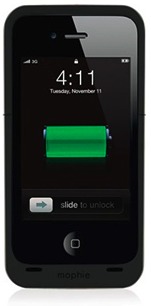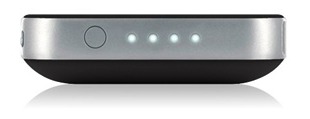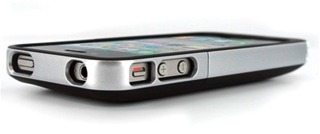Mophie Juice Pack Air Powers Longer iPhone GPS Use
I’ve been travelling the last 10 days, speaking at the MacinTech Users’ Group in Denver and CoMUG in Boulder, before spending some time with family. As usual when I’m on the road, my iPhone has been tremendously helpful, from reporting on Denver’s notoriously unpredictable weather to helping me navigate unfamiliar roads.
I knew I’d be relying heavily on Navigon MobileNavigator while here (see “Navigon MobileNavigator App Bests Standalone Devices,” 6 December 2010), but a quick thought before I left turned out to be essential. My iPhone 4, which I acquired when that model came out in June 2010, seems to be losing battery life slowly. It’s not a problem in normal use at home, since only occasionally will I do things (playing podcasts through its internal speaker while driving, or talking for long periods on Skype, for instance) that drain the battery to the point where I might get a 20-percent warning in the evening.
But the iPhone’s GPS sucks power, draining the battery in about two hours of continual use. And since I’ve become so reliant on Navigon while travelling, it has become all the more important to ensure that the iPhone doesn’t conk out late in the day when I might still need navigation help.
A car charger is an obvious solution, but even then, I’m not always in a situation where I can dig it out and plug in the iPhone; if someone else is driving, for instance, or if I’m on foot. But as I was packing for the trip, I remembered that Mophie had donated a Mophie Juice Pack Air battery-powered iPhone case for the Macworld Expo speaker’s bag, so I tossed it in my laptop bag.
The Juice Pack Air contains a 1500 mAh battery, and in my usage on this trip, I’ve never ended up with the iPhone below about 30 percent of charge at the end of the day, even when I’ve used it for 60-90 minutes of GPS navigation. Mophie also makes the Juice Pack Plus for the iPhone 4; it has a 2000 mAh battery and would last even longer, though how much is impossible to estimate given highly
variable usage patterns. Mophie claims the Juice Pack Air will “virtually double” the iPhone 4’s battery life, whereas the Juice Pack Plus will “more than double” battery life. (There’s also a Juice Pack Air for the iPhone 3G and 3GS; it’s rated at 1200 mAh.)
Four LEDs on the bottom of the Juice Pack Air display the battery status, and one flashes to indicate when it’s charging. While I appreciate the feedback, it would be nice to be able to turn the LEDs off while the Juice Pack Air is plugged in; you have to cover the case to prevent it from illuminating a dark hotel room when you’re trying to get to sleep. A button next to the LEDs does let you turn them on and off while the case is unplugged; ideally it would work when plugged in as well.
Like at least some other battery-powered cases, the Juice Pack Air drains itself first, before the iPhone 4’s battery even comes into play. That’s great, because I’ve run into situations with car chargers in the past where they couldn’t bring a drained iPhone back to life as quickly as I needed. With the Juice Pack Air, the iPhone will be working on its own battery at the end of the day, rather than trying to recharge from the external battery after being drained.
However, for the best possible battery life, Mophie recommends using the Juice Pack Air’s power switch, which lets you go into standby mode, forcing the iPhone 4 to use its own battery. The reason, as I understand it, is that the iPhone 4 uses additional power to be on a constant charge. So while the set-and-forget approach I’ve been using works well and is the easiest, toggling in and out of standby mode might be worthwhile when you need to squeeze as much power as possible out of the two batteries.
Physically, the two-piece Juice Pack Air increases the size and weight of the iPhone noticeably, bumping the height from 4.5 inches (115.2 mm) to 5.07 inches (128.78 mm), the width from 2.31 inches (58.6 mm) to 2.51 inches (63.75 mm), the depth from 0.37 inch (9.3 mm) to 0.68 inch (17.27 mm), and the weight from 4.8 ounces (137 grams) to 7.3 ounces (207 grams).
But while the iPhone 4 is distinctly larger and heavier when wearing the Juice Pack Air, it still fits comfortably in my jeans pocket, and it’s smooth and rounded for easy insertion and extraction. Unfortunately, it does not fit in the Amphipod Micropack Explorer that I bought to carry the iPhone 4 on runs while I’m travelling and when I might need either GPS assistance to find my way or the phone to call for assistance if I get really lost. Other carrying cases will undoubtedly have the same problem.
(As an aside, the Amphipod Micropack Explorer generally works well for carrying the iPhone in a pouch that clamps securely inside the waistband. The only problem is that my 1980s-style nylon running shorts aren’t tight enough to prevent the pouch from bouncing a little when worn in front; it was more solid when worn on the back of my waist, and was totally fine anywhere with running tights.)
The Juice Pack Air does plug into (and thus cover) the iPhone 4’s dock connector, but it provides access to all the iPhone buttons, the camera, and the speakers. For syncing with iTunes, the loss of the dock connector isn’t an issue, since the USB cable that comes with the Juice Pack Air works fine for syncing and charging (from either a computer or Apple’s USB wall adapter). And if you need to get to the dock connector for another reason, it’s trivially easy to slip the small top part of the Juice Pack Air off, and extract the iPhone from the larger bottom piece.
Mophie claims that the Juice Pack Air improves the sound from the iPhone 4’s speakers by redirecting it from the bottom to the front. Honestly, I haven’t noticed any difference, though I suspect the position and orientation of the iPhone matters.
In the end, the Juice Pack Air performed its given task admirably, ensuring that I never ran out of battery power during normal travel usage. In only one case — when Tonya and Tristan and I were hiking in the Rocky Mountain National Park and I wanted to make sure the iPhone didn’t waste battery power searching for nonexistent cell service — did I adjust my usage patterns to conserve battery life. Every other day of the trip, the iPhone just worked until bedtime, doing everything I asked of it, thanks to the extra power from the Juice Pack Air.
The Mophie Juice Pack Air costs $79.95; the Juice Pack Plus costs $99.95. Both are available directly from Mophie or discounted via resellers like Amazon.com, where the Juice Pack Air is currently priced at $58.58 and the Juice Pack Plus is $75.93 (both prices are for the black models; the Juice Pack Air comes in white and red too, and the Juice Pack Plus also comes in cyan, magenta, and yellow).



Adam, I'm sure this will peg me as a bonafide Luddite. And since I am also so old that I used to be an aircraft navigator (of the human type) I'm sure that seals the deal; yet I press on: I am sure that the Navigon app and the Mophie Juice Pack Air are wonderful devices that will show up soon on my want list. My concern here is the preservation of your personal native skills. While I understand that evaluation of this equipment is your work (you do a splendid job for inadequate compensation), taking a run while on a speaking tour is the perfect moment to forswear your electronic helpers and allow your native human navigation skills to find your way. You'll be exhilarated by the result. As 21st Century humans we have many helpers these days. We must choose wisely. Use it or loose it.
Oh, don't worry, I normally never run with the iPhone at all, and I never ended up needing it while out running in Denver/Boulder either. It was just that I was in a completely unfamiliar area, with no one around who necessarily even knew when I'd left for the run. So carrying it was purely for dealing with unanticipated trouble.
I do always run with my Garmin Forerunner 305, which has a rudimentary mapping function, but it's only slightly helpful for helping complete a loop or retrace steps when thoroughly lost on trails. I've used it once or twice over the years. Normally, the Forerunner is a training aid and for recording where I've been for later reference.
Now, all that said, I do rely heavily on Navigon while driving in unfamiliar areas because it's safer and less time-consuming than attempting to read maps either beforehand or in the car while driving, and it reduces marital stress if Tonya is attempting to provide directions.
What I like most about GPSes is that they actually encourage experimentation, since I will take routes that I'd never chance sans GPS, knowing that the GPS will bail me out if the roads I'm taking randomly don't work out. Pre-GPS, I had to be very conservative about how I'd drive in unfamiliar areas, since a single wrong turn could prove hugely problematic.
Bob, I also flew for quite a few years and remember the advent of electronic navigation. One day when I was working in the Gulf of Mexico, a friend asked our boss if he "Had to go offshore" as his Loran-C was inoperative. He was told that as long as he had a map and the helicopter had a magnetic compas, he better be on his way!
Thanks for the review - timely. I have been considering buying the Juice Pack Air. Could you comment about how the Juice Pack Air might have affected the iPhone reception, 3G and GPS? With the extra layer on the back and sides, might it not hinder reception somewhat?
I believe the Juice Pack Air is entirely plastic (short of the actual battery), and I never noticed any issues with reception while using it, or difference when I removed it. So while it may make a small difference, it wasn't noticeable.